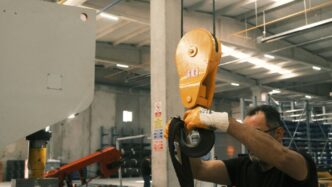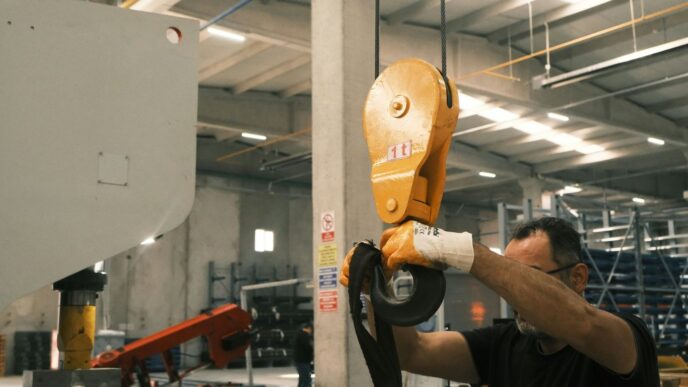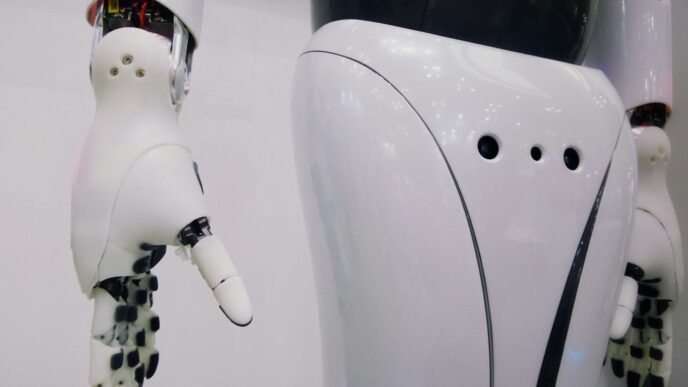So, HP is buying up some of the tech from a company called Humane, the folks who made that AI Pin gadget. Remember that thing? It didn’t exactly set the world on fire. But HP sees something there, maybe a way to put AI into their own stuff like printers and computers. It’s a big move, and it makes you wonder what this whole humane ai hp thing will actually look like down the road. Will it be useful, or just another tech gadget that misses the mark? Let’s break it down.
Key Takeaways
- HP is acquiring AI tech and talent from Humane, the company behind the AI Pin, for $116 million.
- The Humane AI Pin, an expensive standalone AI device, largely failed due to issues like cost, connectivity, and its lack of integration with smartphones.
- HP plans to use Humane’s technology to build an ‘intelligent ecosystem’ across its products, starting with a new ‘HP IQ’ innovation lab.
- The acquisition highlights the challenges of creating standalone AI devices and the continued importance of smartphones in daily life.
- This move signals HP’s effort to integrate AI more deeply into its hardware and services, aiming to improve user experiences across its product lines.
The Humane AI HP Acquisition: A New Chapter
So, HP went and bought some of the tech and brains behind the Humane AI Pin. It’s a pretty big deal, marking a new phase for HP as they try to weave more artificial intelligence into everything they make. This move isn’t just about grabbing some patents; it’s about bringing in people who were working on some pretty forward-thinking, if not entirely successful, AI ideas.
HP’s Strategic Move for AI Capabilities
This acquisition is HP’s way of saying they’re serious about AI. Instead of building everything from scratch, they decided to pick up key pieces from Humane. Think of it like buying a really good engine for a car you’re already building. It speeds things up and brings in specialized knowledge. HP is looking to transform itself into a company that focuses more on user experiences, and AI is seen as the way to get there. This is a big signal to the market that HP is investing in the future of computing. It’s a strategic play to stay competitive in a world that’s rapidly changing because of AI. You can see how this fits into their broader plans, especially with news of significant stock surges following other AI-related developments.
Acquiring Core AI Technology and Talent
What exactly did HP get? Well, they acquired Humane’s AI platform, called Cosmos, which was the brains behind the AI Pin. They also brought on board a team of skilled engineers and researchers who were deep in the weeds with this technology. Plus, there are over 300 patents and patent applications, which is a serious chunk of intellectual property. This isn’t just about software; it’s about the people who know how to build and improve it. Having these folks in-house means HP can directly integrate their know-how into HP’s own product development.
Integrating Humane’s Vision into HP’s Ecosystem
The plan is to take what they learned from Humane and sprinkle it across HP’s product line. We’re talking about everything from AI-powered PCs to smart printers and even conference room setups. The goal is to create what HP is calling an "intelligent ecosystem." This means devices will ideally work together better, powered by AI. It’s about making everyday tasks smoother and opening up new possibilities for users. This integration is expected to happen within a new AI innovation lab called ‘HP IQ’, where the acquired Humane staff will be working. It’s a bold step to make their existing products smarter and more connected.
Lessons Learned from the Humane AI Pin

So, the Humane AI Pin. Remember that? It was supposed to be this big, futuristic thing, a wearable companion that would change how we interact with tech. Instead, it ended up being one of those gadgets that makes you scratch your head and wonder what went wrong. HP picking up some of the pieces shows that even in failure, there are lessons to be learned, and that’s what we’re looking at here.
The Pitfalls of Standalone AI Devices
One of the biggest head-scratchers with the AI Pin was its attempt to be a completely separate device. It was meant to be your intelligent buddy, but it didn’t really connect with the one device most of us can’t live without: our smartphones. This created a bit of a disconnect. Why would someone carry around a new gadget that doesn’t play nice with their phone, which already does so much?
- Overheating and Stability: Early reviews pointed out that the device could get uncomfortably hot, and it wasn’t always reliable. That’s a pretty big hurdle for something you’re supposed to wear.
- Gimmicky Interface: The projected display on your hand, while cool in theory, seemed awkward in practice. It required specific gestures and looking at your palm, which isn’t exactly natural.
- Lack of Integration: The biggest miss was not linking up with existing phones. It felt like a separate island of tech instead of part of a connected system.
The Indispensable Role of Smartphones
It turns out, our phones are pretty central to our lives. They handle so much – from keeping us safe and managing our accounts to being our camera, music player, and personal assistant. The AI Pin, and other similar gadgets, seemed to forget this. They aimed to replace or bypass the phone, but that’s a tough sell when the phone is so deeply woven into our daily routines.
- Ubiquity: Almost everyone has a smartphone. Introducing a new device that doesn’t complement it feels like an uphill battle.
- Functionality: Phones do a lot, and they do it well. Any new device needs to offer a significant improvement or a completely new, compelling experience to justify its existence.
- Ecosystem: Our phones are connected to a vast ecosystem of apps and services. A standalone device struggles to replicate that.
Cost and Connectivity Challenges
Let’s talk about the price tag. The AI Pin wasn’t cheap, and on top of that, it needed its own cellular plan. That’s a lot of money for a device that wasn’t fully proven.
- High Upfront Cost: At $699, it was a significant investment.
- Monthly Fees: Requiring a separate $25-a-month data plan added to the ongoing expense.
- Connectivity Decisions: The choice to not allow pairing with phones via Bluetooth or using a phone’s existing cellular connection felt like a missed opportunity to make the device more accessible and affordable for users.
Ultimately, the AI Pin’s story is a good reminder that new tech needs to fit into people’s lives, not force people to change their lives around it. It needs to be practical, affordable, and work well with the tools we already use.
HP’s Vision for an Intelligent Ecosystem
So, HP snagged some of Humane’s tech and brainpower, right? It wasn’t just about grabbing some code; it was about getting a piece of their vision for how we interact with computers. HP is talking about building this whole ‘intelligent ecosystem’ across their products. Think beyond just a PC or a printer; imagine them all working together, smarter.
The ‘HP IQ’ Innovation Lab
This is where the magic is supposed to happen. HP is setting up this new lab, calling it ‘HP IQ’. It’s basically a place for them to figure out how to weave AI into everything they make. The folks from Humane who know this AI stuff are going to be working there. They’re aiming to make HP’s printers, conference room gear, and yes, even their PCs, all a lot more aware and helpful. It’s like giving all your HP stuff a central brain.
AI Integration Across HP Devices
What does this actually mean for you and me? Well, HP wants AI to be a part of the whole experience, not just a bolted-on feature. They’re talking about making your HP devices talk to each other in a more useful way. Imagine a printer that knows you’re about to run out of ink because your PC flagged a big printing job, or a conference room that automatically adjusts settings based on who’s joining the meeting. It’s about making things smoother.
Enhancing User Experiences with AI
At the end of the day, it all comes down to making things better for the user. HP sees AI as a way to simplify tasks and maybe even anticipate what you need. They want to move beyond just selling hardware and become a company that provides smarter experiences. The goal is to make technology feel less like a tool you have to manage and more like a helpful assistant. This acquisition seems like a big step in that direction, trying to learn from what didn’t work with standalone gadgets and bring that intelligence into the devices we already use.
The Future of Human-Computer Interaction
So, what’s next for how we talk to our tech? It feels like we’re on the edge of something big, moving past just tapping screens. Think about how we interact with things now. We’ve got phones, sure, but the idea is to make that connection feel more natural, almost like an extension of ourselves. This shift is all about making technology work with us, not just for us.
Bridging the Gap with AI
AI is really the key here. It’s not just about making smart assistants that can answer questions. It’s about AI understanding what we need before we even ask. Imagine a device that knows you’re heading into a meeting and automatically silences notifications, or one that suggests the best route home based on traffic and your usual patterns. It’s about making technology predictive and helpful in a way that doesn’t feel intrusive. This is where things like augmented reality start to play a bigger role, blending digital information with our physical world in a way that feels intuitive.
AI’s Role in Creative Industries
Creatives are already seeing some wild changes. AI tools are popping up that can help artists and designers speed up their work. For example, AI can help generate different visual styles or even assist in creating complex visual effects for movies. It’s not replacing the artist, but it’s giving them new tools to play with. We’re seeing AI used in fashion for virtual try-ons and in advertising to create more personalized campaigns. It’s a whole new playground for creativity.
Personalized and Seamless Interactions
Ultimately, the goal is to have interactions that feel personal and just… work. No more fumbling through menus or trying to remember commands. We’re looking at a future where our devices adapt to us. This could mean:
- Contextual Awareness: Your tech understands where you are and what you’re doing.
- Adaptive Interfaces: The way you interact changes based on your needs at that moment.
- Proactive Assistance: AI anticipates your needs and offers help without being prompted.
It’s a bit like having a really good assistant who knows you inside and out. The Humane AI Pin tried to be this, but it missed the mark by being too separate from our existing digital lives. The real win will be when AI is woven into the devices we already use, making them smarter and more responsive to us as individuals.
Navigating the Evolving AI Landscape
It feels like every week there’s some new AI development that makes you stop and think, "Wow, what’s next?" This whole AI thing is moving at a speed that’s honestly a bit dizzying. We’re seeing AI do all sorts of things now, from writing code to creating art, and even designing new genomes. It’s pretty wild.
AI’s Potential and Perils
On one hand, the possibilities seem endless. Think about how AI is already changing fields like healthcare and education. It can help doctors spot diseases earlier or give students more personalized learning experiences. The potential for AI to help us solve big problems is huge. But, like anything powerful, there’s a flip side. We’ve seen instances where AI can be tricked, like that Rorschach test example where it gave multiple answers instead of one. And then there are the concerns about AI being used for bad things, like creating deepfake images that can harm people. It’s a real balancing act.
- AI can help automate repetitive tasks, freeing up human time for more complex work.
- It can analyze massive datasets to find patterns humans might miss.
- AI tools are becoming more accessible, allowing smaller businesses to compete.
Ethical Considerations in AI Development
This rapid progress brings up some big questions we really need to think about. Who is responsible when an AI makes a mistake? How do we make sure AI systems are fair and don’t have biases built into them? And what about privacy? As AI gets better at understanding us, we need to be careful about how our data is used. It’s not just about building smarter machines; it’s about building them responsibly. We need clear rules and guidelines to make sure AI benefits everyone. The development of AI is impacting many sectors, and it’s important to consider the broad impact and revolutionary potential of AI across various fields artificial intelligence (AI) technology has significantly transformed numerous sectors, including healthcare, education, defense, and commerce.
The Pace of AI Innovation
Honestly, the speed at which AI is changing is the most striking thing. Just a few years ago, some of the things AI can do now seemed like science fiction. We’re seeing AI integrated into everything from robotics to fashion design. Companies are racing to create more advanced systems, and it’s hard to keep up. This constant innovation means we have to be adaptable and keep learning. It’s an exciting time, but it also means we need to stay aware of both the good and the bad that comes with it. The goal is to make sure this technology helps us move forward in a positive way.
So, What’s Next?
The Humane AI Pin might be gone, picked up by HP, but the ideas behind it aren’t totally dead. It really shows us that just having AI isn’t enough. People want tech that actually fits into their lives, not something that feels like a weird extra gadget. Phones are pretty good at doing a lot of things, and it’s hard to replace that. Maybe the future isn’t about ditching our phones, but about making AI work better with them, or finding simpler ways for AI to help us without being a whole new thing to manage. We’ll see what HP does with the tech they bought, but the big lesson is clear: make it useful, make it easy, and make sure it actually helps people.












